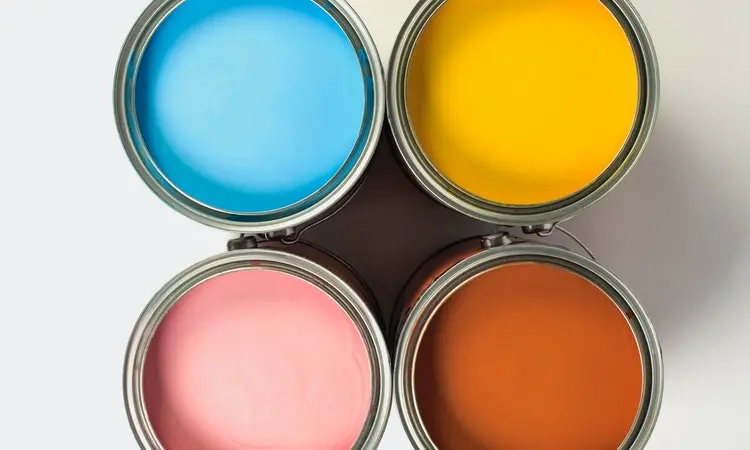So, you’ve finally decided to paint one or more of the rooms inside your house. That’s an excellent idea.
Painting is an easy way to breathe new life into an old spot. Not only will you be happy seeing the painted walls and trim each day, but guests who come over will surely be amazed.
That would leave you holding your head up high and poking your chest out.
However, if you haven’t chosen your paint yet, you are not even close to being at that point. Once you decide what you’ll be painting, bedroom, living room, bathroom, etc., you must turn your attention to picking the right paint – acrylic or latex.
You’re in luck if you’d like to learn more about the characteristics that acrylic and latex paints bring to the table. That’s exactly what I’m here to discuss with you today.
Thus, stay put and read on to learn more. Then, you should be able to select the appropriate paint for your next home improvement project.

Brief Overview of Acrylic Paint
In the past, the only options homeowners had when it came to interior and exterior house painting was oil and water-based.
Then, a breakthrough occurred, and acrylic paint arrived on the scene. It isn’t the perfect solution for every job, but the formula provides various benefits when it is.
Some of the top perks associated with using acrylic paint include:
- Mildew resistant
- Flexibility to expand and contract without cracking
- Fast drying
- Low odor
Also, acrylic paint is breathable. As such, moisture can escape instead of getting trapped and blistering.
Did you know acrylic paint maintains its sheen longer than many other paints? It’s true. For those unfamiliar with the lingo, sheen also means shine or shininess.
Of course, no true overview would be complete without discussing the cons. Some people don’t like using acrylic paint because it will show brush marks in the end if they aren’t careful.
Additionally, this alternative isn’t as durable as oil-based paint. Therefore, if you use it in a high-traffic area, don’t be surprised if it gets damaged or scuffed.
Brief Overview of Latex Paint
Latex paint is a great choice for interior and exterior jobs. This product is also often called acrylic latex.
That’s because it has a plastic resin within it, which is made of either polyvinyl or acrylic. The resin gives the paint the ability to adhere to surfaces securely and with ease.
One benefit people appreciate about latex paint is that it’s simple to clean up because it’s water-based. Hence, spills can usually be wiped away with a paper towel or cloth
. If the mess is tougher than that, use a diluted soap and water solution on the spot or spots. That should get them right up.
Plus, it is safe to clean walls, trim, or whatever with soap and water after the paint dries.
Latex paint normally applies with little to no trouble at all. However, if you’re attempting to paint an extremely glossy surface, not sticking could become an issue.
Also, wood grain often inflates after it gets coated with latex. Then, you’ll have more work on your hands, as it will need to be sanded between coats.
Lastly, latex paint cannot be stored where the temperature drops to freezing because it will become thick and unusable.
What are Acrylic And Latex Paint Used For?
This table contains some common possibilities for these two types of paint, but there are many others.
So, do a little research because there’s a good chance one or both paints could be right for your next project.
| Project Area | Acrylic | Latex |
|---|---|---|
| Paper | Yes | No |
| Canvas | Yes | No |
| Wood | Yes | Yes |
| Fabric | Yes | Yes with prep |
| Concrete | Yes | Yes |
| Brick | Yes | Yes |
| Plastic | Yes with prep | Yes with prep |
| Glass | Yes with prep | no |
| Metal | Yes with prep | Yes with prep |
| Walls | Yes | Yes |
| Ceilings | Yes | No |
Differences Between Acrylic And Latex Paint
Basically, the primary difference between the two is the solvent, which gives latex and acrylic paints unique properties.
Below, I will focus on the differences between acrylic and latex paint in more depth to help you see what they’re all about.
1. Composition
As mentioned earlier, the solvent is the primary difference between acrylic and latex paint. But if you didn’t know what it meant then, you still don’t know now, so it is time to address that.
Latex is water-based, while acrylic paint contains chemicals. Meanwhile, the two are similar in that they have waterproof acrylic resins.
Pigments and additives are also commonly found in these two products.
Related Read: What is Paint Made of?
2. Flexibility

If you recall, flexibility was one of the top perks associated with using acrylic paint earlier, and why wouldn’t it be?
Nobody wants their finish to show wear and tear because the house is settling. But how does latex fair in this regard?
Latex paint is not as flexible as its acrylic counterpart. It does not tend to hold up to UV rays and extreme temperature changes, as well as acrylic paint, either. So, latex sometimes peels and cracks quicker than acrylic when used outside.
3. Water Resistance
Once latex and acrylic paint cure fully, they are both very water-resistant. Therefore, you can use them outdoors or paint kitchens and baths.
Just be sure to get an exterior product for the outside. However, latex has the harder shell of the two.
Thus, it is usually better suited for spots that need to be cleaned regularly, as the additional scrubbing won’t cause scratches or scuffs to develop.
4. Cost
If you’ve ever been to a store where paint is sold, you know there are tons of options on the shelf. Hence, prices will vary.
You might find something on sale, making it cheaper than another product, and vice versa. However, generally speaking, acrylic paint usually has a higher price tag than latex paint.
So, if you’re all about saving money on your home improvement venture, the latter might be the best bet.
5. Dry Time
Another difference between acrylic and latex paint is how long they take to dry and cure.
A thin layer of acrylic paint can sometimes dry in as little as 30 minutes, but a thin layer of latex paint will typically dry to the touch in about an hour. Of course, thicker layers will require longer dry times.
As for a second coat, you should be able to do that with latex paint in about four hours.
Meanwhile, acrylic is the same at four hours, but some research suggests you should wait as long as eight to 12 hours before putting on a second layer. Curing between latex and acrylic paint varies a bit as well.
For latex paint, it is usually two to four weeks before it is fully cured. Then, there’s acrylic. It requires a minimum of 21 days and a maximum of 30 days to cure.
6. Thickness
Acrylic paint is thicker than products of the latex variety. That means they aren’t as likely to run when they’re being applied.
The thickness also gives the paint a bold and vivid finish.
However, it’s kind of like a double-edged sword because the application of acrylic is typically more challenging than that of latex.
Also, each coat of acrylic has to be put on thin. In turn, more coats will be required to get it to the thickness where it needs to be.
Due to these issues, it is often recommended that beginners start with latex paint. It is easier to work with and will give them the experience to tackle more advanced projects in the future.
7. View
Another difference that acrylic and latex paint is the way people view the products.
When individuals hear the words latex paint, usually, their minds immediately jump to house paint. That isn’t necessarily the case with acrylic paint, though.
People hear that and think of artists. They imagine small tubes or bottles of paint sitting near an easel.
Then, there’s house paint, which comes in a gallon can or a 5-gallon bucket. The point is that people don’t always view acrylic and latex paint as the same.
8. Toxicity

For the most part, most acrylic paints are non-toxic, and the same can be said for latex paints. Even the paint fumes of the latter are safe.
They might make you feel nauseous, but generally, they’re safe. The same sentiment goes for acrylic paint.
However, manufacturers sometimes include chemicals in their products that make the fumes toxic. That is what happens with acrylic paint.
Thus, be sure to increase the ventilation where you’re working by opening windows and doors. Also, you should probably use a mask or respirator when painting walls, ceilings, and more indoors.
There’s no point in giving health hazards a chance to arise.
So, use safety equipment when necessary to keep issues at bay. Your well-being is the most important thing.
9. Colors
If you need a color or shade that is somewhat out of the ordinary, acrylic paint might not be the solution for you.
Yes, the paint does come out vivid and bright; there is no doubt that. However, there is a good chance that your local hardware store will have many latex paint products.
Meanwhile, their acrylic paint selection could be lacking. That is usually the case.
Therefore, if you have a specific color in mind, latex is the better option.
Can Acrylic Paint Be Used Over Latex Paint?
As is the case with latex paint, acrylic paint is water-based. Therefore, there typically are no conflicts when covering latex with acrylic.
If something happens, more often than not, a human error is involved. For example, many people try to apply the acrylic coat before the latex is fully dry.
When that happens, the two paints fail to bond. Then, once the acrylic dries, it peels. Nobody wants to look at such an eyesore.
Nor do they want to redo their hard work just a short time later. So, ensure the latex is cured all the way through ahead of applying the acrylic paint. That could save you some grief in the long run.
Can You Use Latex Paint Over Acrylic?
Latex paint can be used to cover acrylic paint in the same way that acrylic paint can be used to cover latex paint.
Both formulas are water-based, so there aren’t any adverse reactions between incompatible ingredients like water and oil.
Plus, acrylic paint normally doesn’t dry glossy. Instead, it is chalky and textured. Henceforth, the latex is able to adhere to it and form a strong bond.
Can I Mix Acrylic And Latex Paint?
Latex and acrylic paints can be mixed. As mentioned before, latex paint has a plastic resin, which is often made of acrylic.
Thus, latex paint is often called acrylic latex. People even go as far as to use the words latex and acrylic interchangeably.
So, if you want to try and make a particular color or texture, that is your prerogative. Think outside the box, let your creativity flourish, and see what happens.
But don’t jump to the middle of your room and put a big streak down the middle of the drywall. What if you don’t like it?
Perhaps the color isn’t what you thought it would be, or the texture is off. Don’t put yourself in that predicament.
Instead, test the latex, acrylic, or mixed paint in an inconspicuous location. Use a brush to put a line or two behind a picture frame.
Then, if it isn’t what you imagined, you can just rehang the picture until you find something you like. If you’re painting outside, roll the paint on behind hedges or other pieces of landscaping.
If you don’t love it, stop once again, but if you’re all about the paint, it’s now time to clean. After all, you don’t want mildew to bleed through.
And you probably won’t be too keen on the idea of your paint peeling due to a contaminant on a surface.
So, take the time to clean. Then, once everything dries, finish painting. Wait for the first coat to dry, and apply a second coat if necessary.
Ways To Apply Latex And Acrylic Paint

Latex paint is often applied to surfaces via brush or roller. Many people also spray the paint on walls, trim, and more via sprayers.
It is usually easy to create a smooth and even coat with latex, regardless of how it’s put on.
Acrylic paint can also be spread with a roller or a brush. I even found an article that suggests it can be used in an airbrush if thinned to the appropriate consistency.
So, if that’s something that piques your interest, consider giving it a try. Afterward, because these two paints are water-based, cleaning up should be a breeze.
In some situations, you can apply acrylic and latex paint with a sponge. This technique allows you to cover only bits and pieces of a wall, which creates layered coloring.
All you have to do now is decide which application method is right for you. Decisions, decisions, what will you do?
What Temperature To Apply Latex And Acrylic Paint?
Luckily, the temperature outside doesn’t have to be exactly 85 degrees or some other exact number to paint with acrylic or latex.
Instead, you have a range of temperatures in which it’s okay to paint with each of them.
Most manufacturers recommend for acrylic paint be stored and used between 60 and 75 degrees Fahrenheit.
As for latex paint, the temperatures are pretty similar but a little different. You should wait to put latex paint on walls unless it’s between 50 and 85 degrees Fahrenheit.
That’s when you’ll have the best success with the paint applying smoothly and drying successfully.
So, depending on where you reside, it probably won’t be too challenging to find a good day to paint and regardless of whether you’re using an acrylic or latex product.
Why is latex paint better For Large Areas?
You can do as you wish, but it is usually recommended that latex paint be used over acrylic to paint large areas.
The reason isn’t how long it takes one item to dry over the other. The figures for each type of paint were pretty similar in that regard.
Rather, it has more to do with latex being sold in larger quantities. And don’t forget about the price difference discussed.
Acrylic paint is often more expensive than latex. Hence, if you go with acrylic, not only are you likely to get less paint in each container you purchase, but you’ll have to buy more cans to do the job.
That sounds like I’m bashing acrylic, but I am not. One cannot forget that acrylic is considered more durable, elastic, and flexible than latex.
You get what you pay for, as the saying goes, so if you can afford to go that route, you’ll probably be extremely happy with the purchase in the end.
Just be prepared to spend more of your hard-earned cash than you would have had you chosen latex.
Some Final Thoughts
The hope is that you know the differences between acrylic and latex paint. With any luck, you also know some pros and cons associated with these two products.
Now, the only thing left to do is get started. Hence, decide what to paint, head to the store to grab your latex or acrylic paint, and you’ll soon discover its perks for yourself.
Then again, you can always pick up both types of paint if you wish since they can be used together effortlessly.



